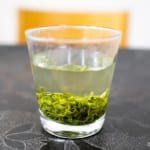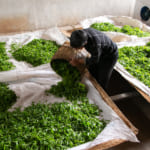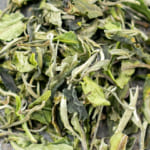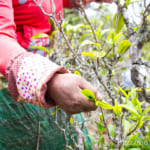- HOME >
- Tea Processing
The role of stem in tea
- [2013.06.22] Posted By Akira Hojo
Did you know the stem of tea is an important factor that affects the taste of tea? Japanese green tea is usually made of 1 bud and 2 leaves where the aracha (or mao-cha in Chinese, means the crude tea right after the process) contains noticeable amounts of stems. However, the stems are removed during the sorting process subsequently.
Removing stems for the sake of the appearance
For Japanese tea industry (while even for most of the teas in China and Taiwan), the appearance of the tea leaves are one of the most important criteria. Therefore, tea manufacturers work very hard to remove the stem due its colour that are of lighter green, to make sure that the appearance of tea is in dark green colour. Using high-tech equipment such as a colour sorting machine, the stems will be effectively removed. However, a tea without stems produces a flatter taste plus spreading of the flavour would be reduced. I conducted an experiment as follow to demonstrate the effects of the tea stems against the tea produced.
Manually remove the stem from Aracha and compare the effect
I prepared an aracha that contains stems and I manually removed the stems and compared the taste between aracha, stems and tea without stems simultaneously. In an amount of 3-5g of aracha which is meant for a 1 time brewing, it does not contain too many stems; perhaps a range from a few to several stems. The results obtained shows that the differences are extremely obvious and noticeable. The aracha that contained stems produces a stronger body and naturally we felt that the flavour is stronger and widely spread. However, the aracha that had leaves without stems produced less flavour and lighter body.

On the left is the manually-sorted stems, the center is the tea without stems and the one on the right is the aracha that contains stems. Most of the Japanese green teas are processed as a tea shown in center. They are sure to remove the stem to obtain a beautiful and consistent appearance of tea even if it sacrifices the taste.
The stems of vegetable are sweet
If you take vegetables as an example, it is easy to imagine why the stem is so essential.
If you eat celery, which part do you enjoy most between the stem and the leaves?
When you eat spinach, which part is sweeter between stems and leaf?
Generally, we would enjoy the taste of the stem more compared to the leaves, regardless of eating the vegetables as salad or cooked.
Likewise, the stem of the tea is sweet and it produces a stronger body than the leaves. That is why Karigane is very popular among our tea line-ups. The Karigane does not have a strong after taste, yet it gives strong body and many customers naturally and unconsciously enjoy it. Based on this concept, I purposely remain the stems when I process Japanese green tea. For all Sencha and Hojicha that I released since last year, I stopped removing the stems. Personally, tea was meant for us to drink and enjoy its fullest and richest taste. I would not sacrifice the taste for the sake of its appearance.
Related Articles
How to get the latest update on HOJO?
1. Follow Twitter, 2. Click "Like" on Facebook, and 3. Subscribe in newsletter. You can have the latest tea news from HOJO.
 Subscribe the Newsletter to enjoy the privileges
Subscribe the Newsletter to enjoy the privileges- You may receive a free sample upon purchase, or you may have the priority to purchase special products. So please remember to subscribe our newsletter as well as the social network.
- Bi Luo Chun: Exquisite Green Tea from East Dongting Shan
- Bi Luo Chun is one of China’s most famous green teas, renowned for its superior quality and unique flavo …
- New Release of Wild Pu-erh Jasmine Pearl
- Out of curiosity, we decided to create a jasmine tea based on Da Xue Shan Wild Raw Tea. This resulted in an ex …
NEW ARTICLES
 Bi Luo Chun: Exquisite Green Tea from East Dongting Shan
Bi Luo Chun: Exquisite Green Tea from East Dongting Shan- Bi Luo Chun is one of China’s most famous green teas, renowned for its superior quality and unique flavo …
 Unexpected Tea Growth in the 2024 Yunnan Tea Season
Unexpected Tea Growth in the 2024 Yunnan Tea Season- After completing an extensive procurement trip in Yunnan Province, I am currently staying in Kuala Lumpur, Mal …
 Three Completely Different Ways to Enjoy White Tea
Three Completely Different Ways to Enjoy White Tea- White tea has been gaining popularity and attention recently, prompting exploration into various ways to enjoy …
 New Release of Wild Pu-erh Jasmine Pearl
New Release of Wild Pu-erh Jasmine Pearl- Out of curiosity, we decided to create a jasmine tea based on Da Xue Shan Wild Raw Tea. This resulted in an ex …
 2024 Overview: Our Yunnan White Tea Quality, Process, and Weather Insights
2024 Overview: Our Yunnan White Tea Quality, Process, and Weather Insights- One of the teas we’ve been focusing on in Yunnan Province is white tea. Historically white tea has been …
 Yunnan’s Hospitality Culture: Expressed Through Meals
Yunnan’s Hospitality Culture: Expressed Through Meals- In China, as a form of greeting, it’s common to say “你吃饭了吗?” which means “Have you eat …
 In Search of Wild Tea: Exploring Mountain Villages in Southwest Lincang, Yunnan
In Search of Wild Tea: Exploring Mountain Villages in Southwest Lincang, Yunnan- We are currently sourcing tea in the southwestern part of Lincang City, Yunnan Province. One of the crucial pr …
 New Release of Anxi Traditional Oolong
New Release of Anxi Traditional Oolong- Anxi, located in Fujian province, China, is celebrated for its Tie Guan Yin tea. However, the Traditional Anxi …
 Yunnan 2024 Spring Tea Sourcing
Yunnan 2024 Spring Tea Sourcing- Yunnan Province is globally renowned for the exceptional quality of its tea leaves. However, lax production ma …
 The Relationship Between Greenness of Tea Leaves and Fertilizer
The Relationship Between Greenness of Tea Leaves and Fertilizer- For both tea and vegetables, there’s a common misconception that a deeper green colour indicates better …
Category
- New Arrival at HOJO Online Shop
- Featured Articles
- Newsletter
- Types of Tea
- Origin of Tea
- Teapot and Tea Equipment
- Tea Column
- How to enjoy tea
- Tea Processing
- How to choose quality tea
- Tea constituents and functional effect
- Safety of Tea
- Foods
- Tea Business Operation
- Hobby and Outdoor Activity
- Ranking of Tea
- Video
- FAQ
- Media Release
Profile

- AKIRA HOJO
- I invite you to experience my tea selections.I was born in Nagano, Japan. In university, I studied agricultural chemistry, and I have the master degree in food science. I worked in Japanese food industry for 10 years. I involved in R&D, QC and QA. As a factory manager, I implemented ISO9000 series and managed the factory.
- The Art of Tea Magazine
- We posted the article on “The Art of Tea Magazine No.9, the magazine is published in Taiwan. We featured …
- New Straits Times
- The Malaysian National Newspaper, New Straits Times featured HOJO Tea on 17-Oct-2007.
Shop Info

Address:Lot No. T-215, 3rd Floor, The Gardens Mall, Mid Valley City, Lingkaran Syed Putra, 59200 Kuala Lumpur
Tel: +603-2287-4537
Business Hour: 10am to 10pm















